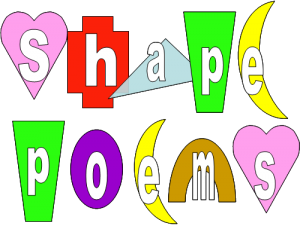SHAPE POEMS AND CALLIGRAMS
Shape Poems (or Calligrams)
These are poems which, as the name suggests, are written in a shape which represents the subject of the poem.
You may also hear the names:
“Concrete poem” (which is more appropriate to geometrical shapes such as a pyramid or square), or
“Patterned poem” (which covers a number of other specific forms which have particular shapes and formats.)
We will not be covering these here, but will look at shape poems specifically, which can be any shape that the writer chooses. These are always a favourite with children as they are able to combine imagination and artwork with their writing, and therefore the poem is not reliant completely on literacy skills.
Tip.. be careful that the poem still has some good figurative writing within it. A shape poem is a challenge in itself, so it becomes extremely difficult to add rhyme and rhythm as there are so many different aspects to get right, and each affects the other, so I strongly recommend that you do not attempt to achieve all of them. Focus on figurative writing skills instead and have some fun with the shape. When some of the aspects of poetry have started to become second nature to you, you can treat rhyme and/or rhythm as a challenge to progress on to if you choose, although it is not a requirement of a shape poem.
An excellent link is included below which helps with the ideas and the layout when making up a shape poem. Follow the link and have a go. www.readwritethink.org/files/resources/interactives/shape/ When you do, make sure that you concentrate on what the poem is saying as well as what it looks like.
For example. when writing about a leaf:
- Imagine it under a microscope and describe the detail (veins like a map to the roots of your lifeblood);
- Describe the feel and texture (soft and rubbery in summer, dry, crinkled, brittle in autumn);
- Think of the sounds it makes: imagine it’s journey to the ground when it falls from the tree (swaying to earth as if on an imaginary rocking chair, drifting, floating, effortlessly etc);
- Describe the shape (like a teardrop falling from the tree, heartshaped etc)
(I wrote the two examples “Tears of Rain” and “Dancing Leaves” whilst using the above website to guide my thoughts.)
Use personification…
- Write the poem as if the object is saying “I am” and describing itself. For example, as with the idea of a leaf… “I fall from my life blood and wave farewell as I drift without a care to the ground”.
- Alternatively, try wondering about the personality of your object (see my poem “Unashamed Blob“), and imagine it as a thinking, living object.
A handy hint:
Choose a simple shape like the suitcase shape of my poem “Evacuee“,or a cloud, for example, as these can be adapted in shape and size as you go along. Also, it is easier to do a shape poem by hand rather than computer as you can vary the size and positioning of your writing and word spaces as necessary. Honestly, believe me, it is much easier!
Topic work … nature, weather, bonfire night etc
Topic work is ideal for writing shape poems. Try to think about the shape that you use, as it needs to be an easily recognised , block silouette. Some shapes could not be made using words without the reader struggling to follow the order of the words.
Look at some examples of shape poems
Shape poems are good to analyse WHY the writer has written the poem in a particular shape or word order etc. Sometimes, it is not always easy to follow the word order of a shape poem as the author deliberately writes some word play into the idea. (See my poem called “Escalating Ambition“)
Use art to write a word according to its meaning…
See my poem “Opposites” to see how each word is represented by it’s own shape
If you would like to see examples of my shape poems, you will find them under the category POEM FORMS and the sub heading SHAPE POEMS . Many of my poems will, of course, come under several different categories above, but they are duplicated deliberately so that you can find them by whichever means you need to use them. Poems are also listed alphabetically in the POEM INDEX by title.

Comments on this entry are closed.